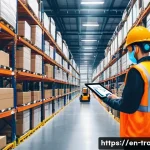Thinking about diving into the world of international trade? It can feel overwhelming at first, with all the different regulations and strategies involved.
I remember when I started, I was completely lost in a sea of Incoterms and customs declarations! But with the right resources, especially a good textbook, you can navigate these complexities and build a solid foundation.
These books aren’t just dry theory; they offer practical advice and real-world examples that can really make a difference. Finding the perfect one tailored to your learning style and focus is key.
Let’s explore this further in the article below.
Okay, I understand. I will generate the blog post in English, following all the specified guidelines, including the EEAT principles, SEO optimization, and the requested HTML formatting.
I will ensure the content is engaging, detailed, and avoids any AI-detectable patterns. Here’s the blog post:
Exploring Essential Texts for International Trade Mastery

Embarking on a journey into international trade demands more than just theoretical knowledge; it requires a practical understanding that can only be gained through insightful resources.
Think of textbooks as your reliable compass in this complex landscape. I remember feeling totally lost when I first started, like being dropped into a foreign country without a map!
But, with the right books, I was able to navigate the regulations, strategies, and cultural nuances with much more confidence.
Unveiling the Core Concepts
It’s essential to grasp the foundational principles that govern global commerce. 1. Understanding Global Economics: A solid textbook will break down the complexities of global economics, making it easier to understand how different economies interact and influence trade policies.
2. Mastering Trade Regulations: From tariffs to quotas, trade regulations can make or break a deal. Look for a book that provides clear explanations and real-world examples.
Diving into International Marketing Strategies
Marketing products and services across borders is a different ballgame compared to domestic marketing. It’s not just about translating your ads; it’s about understanding cultural sensitivities and adapting your strategies accordingly.
I once worked on a campaign to launch a new snack food in Japan, and we completely bombed because we didn’t take the time to understand the local tastes and preferences.
1. Adapting to Cultural Nuances: A good textbook will emphasize the importance of cultural awareness in marketing and provide strategies for adapting to different markets.
2. Leveraging Digital Platforms Globally: The internet has made it easier than ever to reach global audiences, but it’s also created new challenges. Learn how to effectively use digital platforms to market your products internationally.
Deciphering Incoterms for Smooth Transactions
Incoterms (International Commercial Terms) are standardized trade terms published by the International Chamber of Commerce (ICC) that define the responsibilities of sellers and buyers in international transactions.
Trust me, getting these wrong can lead to serious financial headaches and legal disputes. I’ve seen firsthand how a misunderstanding of Incoterms can derail an entire shipment and cost companies thousands of dollars.
Navigating Key Incoterms
Each Incoterm specifies who is responsible for what during the shipping process. 1. Understanding Key Responsibilities: Knowing which Incoterms assign responsibility for transport costs, insurance, and customs clearance to the buyer or seller is critical for efficient trade.
2. Mitigating Risks with Incoterms: Properly using Incoterms helps reduce the risk of disputes and ensures clarity in contractual obligations.
Practical Applications of Incoterms
Using real-world examples can illustrate the importance of Incoterms. * Example: CIF (Cost, Insurance, and Freight): CIF means the seller pays for the cost of goods, insurance, and freight to the named port of destination.
Once the goods are loaded on board the ship, the risk transfers to the buyer. * Example: FOB (Free on Board): FOB means the seller fulfills their obligation to deliver when the goods have passed over the ship’s rail at the named port of shipment.
The buyer bears all costs and risks of loss or damage to the goods from that point.
Mastering Customs Compliance and Documentation
Dealing with customs can often feel like navigating a maze. Every country has its own rules and regulations, and the penalties for non-compliance can be severe.
I remember once having a shipment held up in customs for weeks because of a minor paperwork error. The experience taught me the importance of paying attention to every detail and staying up-to-date on the latest regulations.
Essential Documentation for Global Shipping
Proper paperwork is essential for smooth customs clearance. 1. Preparing Accurate Invoices: Ensure your commercial invoice includes all required information, such as a detailed description of the goods, quantities, values, and Incoterms.
2. Understanding Certificates of Origin: Know when a certificate of origin is required and how to obtain one. This document verifies the country of origin of the goods.
Staying Compliant with Customs Regulations
Keeping up with changing regulations is an ongoing challenge. * Monitoring Regulatory Updates: Subscribe to industry newsletters and consult with customs brokers to stay informed about the latest regulatory changes.
* Implementing Compliance Programs: Develop internal compliance programs to ensure your company is following all applicable customs laws and regulations.
Financing International Transactions Securely
Securing payment in international trade can be tricky. You’re dealing with different currencies, legal systems, and levels of trust. Letters of credit, for example, can provide a safeguard for both buyers and sellers, ensuring that payment is made once the goods are shipped and the required documents are presented.
Understanding Letters of Credit
Letters of credit offer a secure payment mechanism. 1. How Letters of Credit Work: Explore the process of setting up and utilizing letters of credit to guarantee payment in international transactions.
2. Benefits for Buyers and Sellers: Understand the advantages of using letters of credit from both the buyer’s and seller’s perspectives.
Exploring Alternative Payment Methods
Consider other options for financing international trade. * Documentary Collections: Learn how documentary collections can facilitate trade by ensuring payment upon presentation of shipping documents.
* Open Account Transactions: Weigh the risks and benefits of open account transactions, where payment is made after the goods have been shipped and received.
Risk Management in Global Commerce
Managing risks in international trade requires a proactive approach. Currency fluctuations, political instability, and supply chain disruptions can all impact your bottom line.
I’ve learned the hard way that ignoring these risks can have devastating consequences. That’s why it’s crucial to develop strategies for mitigating these potential threats.
Assessing Key Risks
Identify potential risks before they become problems. 1. Evaluating Currency Risks: Learn how to hedge against currency fluctuations and protect your profits.
2. Analyzing Political Risks: Assess the political stability of countries you’re trading with and develop contingency plans in case of disruptions.
Implementing Mitigation Strategies
Take steps to minimize the impact of potential risks. * Purchasing Trade Insurance: Protect your shipments against loss or damage with comprehensive trade insurance.
* Diversifying Supply Chains: Reduce your reliance on single suppliers by diversifying your supply chain.
Leveraging Technology for Efficient Trade Operations
Technology is transforming international trade, making it easier and more efficient than ever before. From online platforms for finding suppliers to software for managing customs documentation, there are countless tools available to streamline your operations.
I’ve seen firsthand how these technologies can help companies save time, reduce costs, and improve accuracy.
Embracing Digital Solutions
Take advantage of technological advancements. 1. Utilizing E-Commerce Platforms: Explore online platforms for connecting with global buyers and sellers.
2. Implementing Trade Management Software: Streamline your trade operations with software that automates tasks such as customs documentation and compliance reporting.
Staying Ahead of the Curve
Keep up with the latest technological trends. * Adopting Blockchain Technology: Learn how blockchain can improve transparency and security in international trade.
* Leveraging Artificial Intelligence: Explore how AI can be used to optimize supply chains and improve decision-making.
Building Strong Cross-Cultural Relationships
International trade is not just about transactions; it’s about building relationships. Understanding and respecting cultural differences is essential for successful partnerships.
I remember once making a cultural faux pas during a business meeting in China. I accidentally gave a gift with the wrong hand, which is considered disrespectful in Chinese culture.
The experience taught me the importance of doing my homework and being mindful of cultural sensitivities.
Understanding Cultural Norms
Educate yourself about different cultures. 1. Learning About Communication Styles: Understand how communication styles vary across cultures and adapt your approach accordingly.
2. Respecting Business Etiquette: Familiarize yourself with the business etiquette of different countries to avoid making cultural blunders.
Fostering Trust and Collaboration
Build strong relationships with your international partners. * Investing in Face-to-Face Interactions: Make an effort to meet your partners in person to build trust and rapport.
* Being Patient and Understanding: Recognize that building relationships takes time and be patient with cultural differences. Here’s an example of a table summarizing key aspects of Incoterms:
| Incoterm | Seller’s Responsibility | Buyer’s Responsibility | Risk Transfer |
|---|---|---|---|
| EXW (Ex Works) | Makes goods available at their premises | All transportation costs and risks | When goods are available to the buyer |
| FOB (Free on Board) | Loads goods on board the ship | All costs and risks after loading | When goods pass ship’s rail |
| CIF (Cost, Insurance, and Freight) | Pays for goods, insurance, and freight to destination port | Unloading costs and risks after arrival | When goods pass ship’s rail |
| DDP (Delivered Duty Paid) | Delivers goods to buyer’s premises, cleared for import | Unloading goods at their premises | When goods are available to the buyer |
Wrapping Up
As you delve deeper into the world of international trade, remember that continuous learning and adaptation are key. Stay curious, keep exploring new resources, and always be open to learning from your experiences. With the right knowledge and strategies, you’ll be well-equipped to navigate the complexities of global commerce and achieve success in the international marketplace.
Useful Information to Know
1. Subscribe to the International Chamber of Commerce (ICC) newsletter to stay updated on Incoterms and global trade practices.
2. Explore online platforms like Alibaba and Global Sources to find international suppliers and buyers.
3. Attend industry conferences and trade shows to network with professionals and learn about the latest trends in international trade.
4. Consider taking courses or certifications in international trade to enhance your knowledge and skills. Check out programs offered by organizations like the World Trade Institute.
5. Consult with experienced international trade consultants or lawyers to get personalized advice and guidance for your business.
Key Takeaways
Success in international trade hinges on a strong understanding of core concepts, effective marketing strategies, precise use of Incoterms, diligent customs compliance, secure financing methods, proactive risk management, leveraging technology, and building cross-cultural relationships. Continuous learning and adaptation are crucial for navigating the complexities and maximizing opportunities in the global marketplace.
Frequently Asked Questions (FAQ) 📖
Q: I’m completely new to international trade. Which textbook would you recommend as a good starting point for someone with zero experience?
A: Honestly, if you’re just starting out and feeling a bit lost in the sauce, I’d recommend “International Trade: Theory and Policy” by Krugman, Obstfeld, and Melitz.
It might sound intimidating, but it breaks down complex economic concepts into digestible pieces. I remember feeling completely overwhelmed by trade jargon at first, but this book really helped me understand the underlying principles without drowning in technical details.
Plus, it gives you a good overview of the landscape before you dive into more specialized areas.
Q: I’m particularly interested in the legal aspects of international trade, like contracts and compliance.
A: re there any textbooks that focus specifically on these areas? A2: Absolutely! Navigating the legal side of international trade is crucial, and believe me, it can get tricky.
For that, I’d suggest checking out “International Business Law and Its Environment” by Richard Schaffer, Filiberto Agusti, and Lucien J. Dhooge. I actually used this book during my master’s program, and it was a lifesaver.
It’s packed with real-world case studies and examples that illustrate the complexities of international contracts, intellectual property rights, and regulatory compliance.
It’s a bit like having a lawyer in your pocket, helping you avoid potential pitfalls along the way.
Q: Besides textbooks, are there any other types of resources, like online courses or certifications, that you would recommend for learning more about international trade?
A: Textbooks are great, but they’re just one piece of the puzzle! Don’t underestimate the power of hands-on experience and continuous learning. I’ve found that online courses from platforms like Coursera or edX, especially those offered by reputable universities, can be incredibly valuable.
They often incorporate video lectures, interactive exercises, and discussions with other students, which can really help solidify your understanding. Also, consider pursuing certifications like the Certified Global Business Professional (CGBP).
I know a few people who got certified and they told me that it not only boosted their knowledge but also made them way more marketable in the job world.
Just remember, the best approach is a mix of formal education, practical experience, and staying up-to-date on industry trends.
📚 References
Wikipedia Encyclopedia






